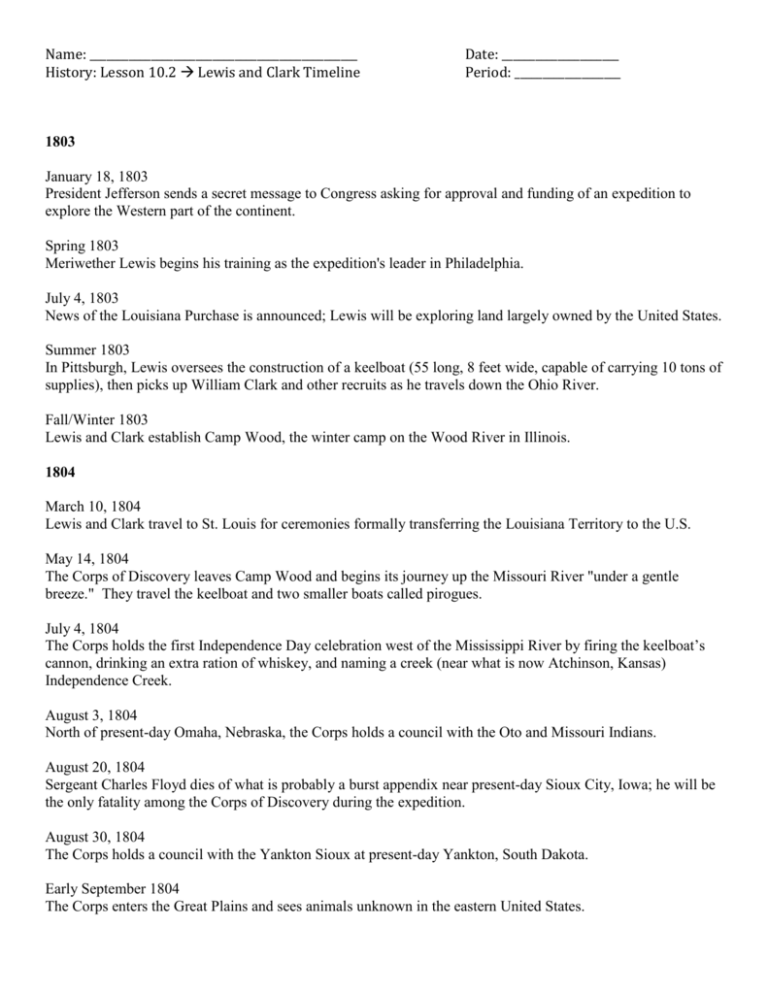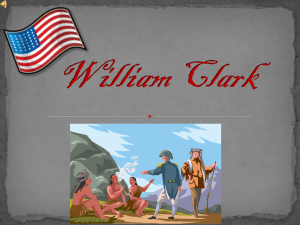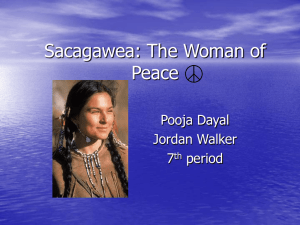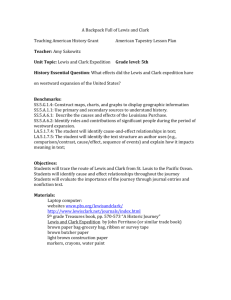History: Lesson 10.2 à Lewis and Clark Timeline Period
advertisement

Name: ________________________________________________ History: Lesson 10.2 Lewis and Clark Timeline Date: _____________________ Period: ___________________ 1803 January 18, 1803 President Jefferson sends a secret message to Congress asking for approval and funding of an expedition to explore the Western part of the continent. Spring 1803 Meriwether Lewis begins his training as the expedition's leader in Philadelphia. July 4, 1803 News of the Louisiana Purchase is announced; Lewis will be exploring land largely owned by the United States. Summer 1803 In Pittsburgh, Lewis oversees the construction of a keelboat (55 long, 8 feet wide, capable of carrying 10 tons of supplies), then picks up William Clark and other recruits as he travels down the Ohio River. Fall/Winter 1803 Lewis and Clark establish Camp Wood, the winter camp on the Wood River in Illinois. 1804 March 10, 1804 Lewis and Clark travel to St. Louis for ceremonies formally transferring the Louisiana Territory to the U.S. May 14, 1804 The Corps of Discovery leaves Camp Wood and begins its journey up the Missouri River "under a gentle breeze." They travel the keelboat and two smaller boats called pirogues. July 4, 1804 The Corps holds the first Independence Day celebration west of the Mississippi River by firing the keelboat’s cannon, drinking an extra ration of whiskey, and naming a creek (near what is now Atchinson, Kansas) Independence Creek. August 3, 1804 North of present-day Omaha, Nebraska, the Corps holds a council with the Oto and Missouri Indians. August 20, 1804 Sergeant Charles Floyd dies of what is probably a burst appendix near present-day Sioux City, Iowa; he will be the only fatality among the Corps of Discovery during the expedition. August 30, 1804 The Corps holds a council with the Yankton Sioux at present-day Yankton, South Dakota. Early September 1804 The Corps enters the Great Plains and sees animals unknown in the eastern United States. September 25, 1804 The Corps has a tense encounter with the Teton Sioux near today's Pierre, South Dakota; one of the Sioux chiefs waves his men off and conflict is averted. October 24, 1804 Near today's Bismarck, North Dakota, the Corps arrives at the villages of the Mandan and Hidatsa, buffalohunting tribes that live along the Missouri River. November 4, 1804 Lewis and Clark hire French-Canadian fur-trader Toussaint Charbonneau and his Shoshone wife, Sacagawea, to act as interpreters on the journey ahead. December 17, 1804 The men record the temperature at 45 degrees below zero, "colder than [they] ever knew it to be in the States." December 24, 1804 The men finish building Fort Mandan, their winter quarters in present-day North Dakota. 1805 January 1805 The Corps attends a Mandan buffalo dance, performed to call buffalo to the area. The Indians and explorers hunt buffalo together. Several expedition members get frostbite, as does an Indian boy whose toes Lewis has to amputate, without anesthesia or a surgical saw. February 11, 1805 Sacagawea's son, Jean Baptiste Charbonneau—nicknamed Pompy by Clark—is born with assistance from Lewis by giving her a potion made by crushing the rings of a rattlesnake’s rattle into powder. April 7, 1805 Lewis and Clark send a shipment of artifacts and specimens to President Jefferson. This includes Indian corn, animal skins and skeletons, mineral samples, and five live animals including the prairie dog. The "Permanent Party" also heads west. April 29, 1805 The Corps marvels at the abundance of game; they kill their first grizzly bear near the Yellowstone River in Montana. Grizzlies will continue to chase the men across the Plains and prove nearly impossible to kill. May 16, 1805 One of the boats nearly overturns and Lewis credits Sacagawea with saving their most important possessions. May 29, 1805 Clark comes across a stream he considers particularly clear and pretty, and names it the Judith River, in honor of a young girl back in Virginia he hopes will one day marry him. (They will be married after he returns home.) May 31, 1805 The Corps reaches the White Cliffs region of the Missouri River. June 1, 1805 The Corps reaches an unknown fork in the Missouri and must determine which branch to choose. June 13, 1805 Lewis reaches the Great Falls of the Missouri—five massive cascades around which the men must carry all of their gear, including the canoes. Late July 1805 The expedition reaches the Three Forks of the Missouri which they name the Jefferson, Gallatin, and Madison in honor of the President, Secretary of the Treasury, and Secretary of State. August 8, 1805 Sacagawea recognizes Beaverhead Rock and knows they are close to Shoshone lands. August 12, 1805 Jefferson receives the shipment from Fort Mandan; Lewis finds the headwaters of the Missouri River, then crosses the Continental Divide and Lemhi Pass to discover that there is no Northwest Passage. August 17, 1805 The main party arrives at the Shoshone camp, where Sacagawea recognizes the chief as her long-lost brother, Cameahwait. August 18, 1805 Lewis celebrates his 31st birthday and vows "in future, to live for mankind as I have [before now] lived only for myself." August 31, 1805 The expedition sets out for the Bitterroot Mountains with many horses and a mule acquired from the Shoshone. September 9, 1805 The men camp near today's Missoula, Montana at a spot they name Traveler's Rest while they prepare for the mountain crossing to come. September 11, 1805 The Corps begins climbing the Bitterroot Range of the Rocky Mountains; the crossing will cover more than 160 miles. Sergeant Patrick Gass calls the mountains “the most terrible mountains I ever beheld,” and John Ordway writes on September 18th, “the mountains continue as far as our eyes could extend. They extend much further than we expected.” September 23, 1805 Starving, the men emerge from the mountains near present-day Weippe, Idaho, at the villages of the Nez Perce Indians. October 7, 1805 After learning a new method to make dugout canoes from the Nez Perce, the men push off down the Clearwater River near Orofino, Idaho; it is the first time they've traveled with the current at their back in almost two years. October 16, 1805 The expedition reaches the Columbia River, the last waterway to the Pacific Ocean. Late October 1805 The Corps must run their canoes through treacherous rapids at The Dalles and Celilo Falls. November 7, 1805 Believing he sees the Pacific, Clark writes, "Ocian in View! O the joy." In reality, they are seeing only the widening estuary of the Columbia River. November 24, 1805 Having reached the Pacific, the entire expedition—including Sacagawea and Clark's slave, York—take a vote on where to build their winter quarters. They choose the Clatsop Indian side of the Columbia, and the encampment came to be called Fort Clatsop. 1806 March 23, 1806 After a winter of only 12 days without rain and many suffering from being homesick, the men present their fort to the Clatsop Indians and set out for home. July 3, 1806 After re-crossing the Bitterroots, the expedition splits into smaller units, in order to explore more of the Louisiana Territory. Clark takes a group down the Yellowstone River. Lewis heads across the shortcut to the Great Falls and then explores the northernmost reaches of the Marias River. At one point the group is split into 4 separate groups. July 25, 1806 Having reached the Yellowstone (with some guiding assistance from Sacagawea), Clark’s group has re-entered the Great Plains, built two dugouts, been stopped on the river by a huge buffalo herd, and now comes to a sandstone outcropping east of present-day Billings, Montana. He names it Pompy’s Tower, in honor of Sacagawea’s son. On the rock face, Clark inscribes his name and the date – the only physical evidence the Corps of Discovery left on the landscape that survives to this day. Lewis and three men, meanwhile, are now 300 miles away, near the Canadian border and what is now Cut Bank, Montana. July 26/27, 1806 Heading back toward the Missouri, Lewis camps with eight Blackfeet warriors. In the morning, the explorers catch the Blackfeet trying to steal their horses and guns. In the fight that follows, two Blackfeet are killed – the only act of bloodshed during the entire expedition. Lewis leaves a peace medal around the neck of one of the corpses, and the explorers gallop away, riding for 24 straight hours. They meet the group with the canoes on the Missouri, and paddle off toward the rendezvous with Clark. August 11, 1806 While hunting for elk along the Missouri River, with Private Cruzatte, who was blind in one eye and nearsighted in the other, Lewis was hit in the buttocks by a bullet. The blow spun him around and slashed a three-inch gash in his hip. His wound was not serious, but Lewis spent the next several days lying faced down in the bottom of a canoe as the party proceeded down river. August 12, 1806 Downstream from the mouth of the Yellowstone, the entire expedition is finally reunited. September, 1806 Speeding home with the Missouri’s current, they cover up to 70 miles a day, often not even stopping to hunt in order to get back sooner. September 23, 1806 Having found an easier route across the country, the men reach St. Louis nearly two and a half years after their journey began and are acclaimed as national heroes. They had been given up for dead by the citizens, who greet the explorers enthusiastically. Fall 1806 The captains are national heroes; as they travel to Washington, D.C., balls and galas are held in the towns they pass through. In the capitol, one senator tells Lewis it’s as if he had just returned from the moon. The men get double pay and 320 acres of land as rewards; the captains get 1,600 acres. Lewis is named governor of the Louisiana Territory; Clark is made Indian agent for the West and brigadier general of the territory’s militia. October 11, 1809 Traveling east along the Natchez Trace in Tennessee, on his way from St. Louis to Washington, Lewis is found dead at Grinder’s Stand, an inn south of Nashville. December 20, 1812 At Fort Manuel in what is now South Dakota, Sacagawea dies. Clark, in St. Louis, assumes custody of Jean Baptiste and her infant daughter, Lisette. 1832 York dies sometime around this time, probably of cholera, after going into the freighting business in Tennessee and Kentucky. Clark had kept him slavery for at least ten years following the expedition before granting him his freedom. September 1, 1838 William Clark had married Julia “Judith” Hancock, for whom he named a river in Montana; been respected as Indian agent (Native Americans called St. Louis the “Red-Headed Chief’s Town”); successful in business; and several times appointed governor of the Missouri Territory (though he lost the first election to be the new state’s governor, after being accused of being too “soft” on Indians). On this date he dies at the home of his eldest son, Meriwether Lewis Clark. Information gathered and edited from: A Timeline of the Trip. Public Broadcasting Service. Retrieved from http://www.pbs.org/lewisandclark/archive/idx_time.html Lewis and Clark Expedition Timeline. National Geographic Society. Retrieved from http://www.nationalgeographic.com/lewisandclark/resources_timeline_1803.html This Day in History: Meriwether Lewis is shot in the leg. (2014). A&E Television Networks, LLC. Retrieved from http://www.history.com/this-day-in-history/meriwether-lewis-is-shot-in-the-leg







